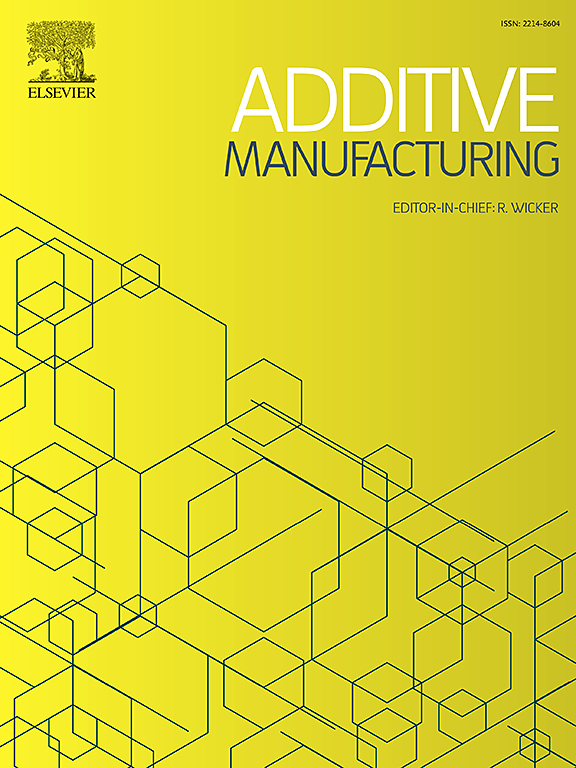原位合金化增材制造亚稳β Ti-12Mo合金的力学性能及变形机理
IF 10.3
1区 工程技术
Q1 ENGINEERING, MANUFACTURING
引用次数: 0
摘要
增材制造(AM) β Ti合金的强度-延性权衡仍然是一个重大挑战。在这项研究中,我们采用了一种经济有效的原位合金化激光粉末床熔合方法,并优化了工艺参数,制备了一种几乎完全致密、化学均匀的β Ti-12Mo合金。然后,我们研究了固溶处理时间如何影响AM Ti-12Mo合金的拉伸行为。固溶处理后的合金在0°和90°方向上均表现出较高的抗拉屈服强度(725-741 MPa)和良好的延展性(22-36 %)。针对垂直于构建方向的潜在变形机制,我们报告了17.9 %的均匀伸长率和明显的应变硬化率(4 %时~ 2300 MPa),我们通过原位高能同步加速器x射线衍射和微观结构表征来阐明。高屈服强度主要归因于Mo-lean胚胎非热ω纳米颗粒的存在。在塑性变形过程中,孪晶和相变都导致了较高的应变硬化速率。在早期(应变<;1.9 %),变形以{332}<; 113 >;β孪晶为主,而在后期,变形诱导的α”相变得显著。α”相的体积分数随应变的增加而增加,支持了连续硬化。值得注意的是,不合理的{112}<; 751 >;β、次级{112}<; 111 >;β和{130}<; 310 >α”纳米孪晶将初级组织限制在纳米晶粒中,并维持应变硬化。本研究为通过增材制造和热处理设计高性能β Ti-12Mo合金提供了思路。本文章由计算机程序翻译,如有差异,请以英文原文为准。
Mechanical properties and deformation mechanisms of metastable β Ti-12Mo alloy fabricated by in-situ alloying-based additive manufacturing
The strength-ductility trade-off in additively manufactured (AM) β Ti alloys remains a significant challenge. In this study, we employed a cost-effective in-situ alloying laser powder bed fusion approach with optimized processing parameters to fabricate a nearly fully dense, chemically homogeneous β Ti-12Mo alloy. We then examined how solution-treatment duration influences the tensile behavior of the AM Ti-12Mo alloy. The optimally solution-treated alloys exhibited high tensile yield strength (725–741 MPa) and commendable ductility (22–36 %) along both the 0° and 90° orientations relative to the build direction. Focusing on the underlying deformation mechanisms perpendicular to the build direction, we report a uniform elongation of 17.9 % and a pronounced strain hardening rate (∼2300 MPa at 4 %), which we elucidate via in-situ high-energy synchrotron X-ray diffraction and microstructural characterization. The high yield strength is primarily attributed to the presence of Mo-lean embryonic athermal ω nanoparticles. During plastic deformation, both twinning and phase transformation contribute to the high strain hardening rate. At the early stage (strain < 1.9 %), deformation is dominated by {332}< 113 >β twinning, whereas at later stages, the deformation-induced α'' phase becomes significant. The volume fraction of α'' phase increases with strain, supporting the continuous hardening. Notably, irrational {112}< 751 >β, secondary {112}< 111 >β, and {130}< 310 >α'' nano-twins confine the primary structures to nanograins and sustain strain hardening. This study sheds light on designing high-performance β Ti-12Mo alloy via AM followed by heat treatment.
求助全文
通过发布文献求助,成功后即可免费获取论文全文。
去求助
来源期刊

Additive manufacturing
Materials Science-General Materials Science
CiteScore
19.80
自引率
12.70%
发文量
648
审稿时长
35 days
期刊介绍:
Additive Manufacturing stands as a peer-reviewed journal dedicated to delivering high-quality research papers and reviews in the field of additive manufacturing, serving both academia and industry leaders. The journal's objective is to recognize the innovative essence of additive manufacturing and its diverse applications, providing a comprehensive overview of current developments and future prospects.
The transformative potential of additive manufacturing technologies in product design and manufacturing is poised to disrupt traditional approaches. In response to this paradigm shift, a distinctive and comprehensive publication outlet was essential. Additive Manufacturing fulfills this need, offering a platform for engineers, materials scientists, and practitioners across academia and various industries to document and share innovations in these evolving technologies.
 求助内容:
求助内容: 应助结果提醒方式:
应助结果提醒方式:


